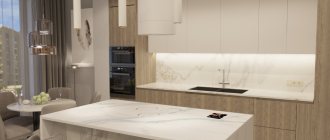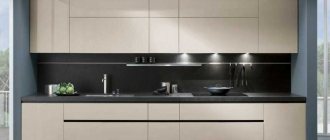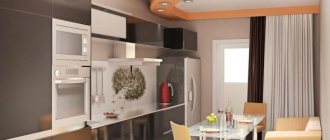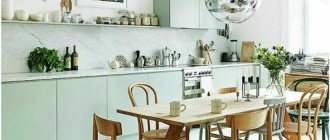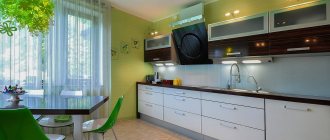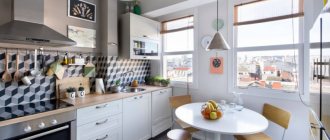With a European sense of sophistication and centuries of rich history, Italian style in kitchen interiors leaves no one indifferent. Italians are not only gourmets who have turned the process of cooking into a real art, but also skillful designers who have managed to create an organic style. It embodies serenity and tranquility, comfort and family characteristics.
An Italian-style kitchen is not only palace luxury, but also cozy country
On the Internet you can find a variety of Italian kitchens, executed in both classical and modern styles, the photos of which are impossible to take your eyes off. From the finishing to the Italian fittings, a kitchen decorated in this style will be the dream of any housewife. It combines family values, iridescence, the mentality of the country, historical features, simplicity and at the same time sophistication. This article will reveal some of the features and secrets with which you can create a warm and welcoming kitchen in the refined style of Italy.
Characteristic features of an Italian style kitchen
- Focus on luxury and aesthetics.
- Predominance of natural materials.
- The presence of a spacious kitchen unit.
- Active use of decor, frescoes, mosaic panels, paintings.
- Warm colors.
- The organization of the interior is in the Italian style of sweet negligence, which gives it a special charm and comfort.
Textile
Italian style allows for the use of bright colored details in the form of oven mitts, curtains for drawers, as well as napkins and towels.
Some companies produce special collections dedicated to different styles. This could be a set that includes pillowcases for sofa cushions, aprons, tablecloths and other elements of home textiles. Decorated with original drawings, they give the interior a special charm and comfort, and also add solemnity to family dinners and bring uniqueness and originality to the design.
The basis of Italian style
Despite the apparent carelessness, the style of the sunny country, which is also called Tuscan, is thought out to the smallest detail: it seems that everything is arranged, hung, but every thing has its own meaning and stands in its place.
With external rustic simplicity, everything when creating the design of an Italian kitchen is subordinated to a common meaning, a single harmony.
Kitchen decor combines elements of everyday life and the environment. The Italian direction of ethno-style is characterized by increased comfort, which attracts kitchen owners. If they enjoy their surroundings, the food tastes better.
Distinctive features of the Italian style: correctly selected colors, emphasis on furniture, correctly selected decorative items.
The unity of the three components will create a harmonious, ergonomic and stylish space.
Italy is a country that honors family traditions, which is why the interior often displays a certain layering, when each generation brings something of its own, so the style allows for the use of rustic finishes in the decoration, and a mosaic panel appearing next to the rough plaster. Blurriness and wear will only complete the stylization.
Decor
Any style is completed by details - lighting, textiles, decorative items that will make your kitchen a piece of Italy and fill it with the air of the Adriatic. For the Italian style, decorative items are not purchased on purpose; they should appear gradually, by chance - something brought from a trip, something given as a gift.
To complete the stylization of interior design, if we are talking about any ethno-style, a good element of decor will be items brought directly from the country, whose style and way of life is recreated in the interior. These can be braided wine bottles, jugs, vases, beautiful dishes, bottles with olive oil and herbs. You can place paintings on the walls - landscapes, still lifes with grapes, wine, fruit. There is also a place for fresh flowers in ceramic pots, herbs in wooden boxes, and wicker baskets in the Italian kitchen.
As for textiles, no rolls, blinds, or granny curtains - only curtains. They can be supplemented with lambrequins, matched with tiebacks, double, triple, lined or unlined. Complemented with tulle and organza - depending on the size of the kitchen. But heavy, thick curtains to the floor and even a little longer are a must.
Classic interior of Italian cuisine
Classical features in the interior of Italian cuisine date back to the era of antiquity. When talking about classical design, one cannot fail to mention such trends as Baroque, Rococo, Biedermeier or Empire.
Despite the fact that these are different styles, they have something in common - the desire for wealth and luxury. Indeed, the classics “scream” with their “palace” luxury, scope and deliberate pomp.
To decorate a room in a classic Italian style, you should focus on bulky and chic furniture made of wood with elements of gilding and velvet.
Renaissance paintings framed with ornate baguettes, candelabras, and bohemian chandeliers have characteristic features of this trend.
When decorating a classic Italian kitchen, it is also important to adhere to balance, correct forms and symmetry. Despite the bulky and luxurious fittings, there should be no unnecessary items in the room. The design of a classic kitchen combines nobility, grandeur, regularity and high cost.
Characteristic features are the stucco ceiling and walls.
Most often, sculptures are used as an accessory. This direction is rich in various half-columns, columns and moldings. You can also find order decor framing door openings. The arch between the kitchen and dining room looks very stylish.
The classic direction of the Italian kitchen interior embodies grace and moderation, but in no way pretentiousness.
Italian cuisines. Rating of new products 2019-2020
21.06.2020
The main events in the field of furniture design for the kitchen occur every 2 years, at the Eurocucina exhibition. Milan usually presents all the new products from leading European manufacturers of kitchen furniture and household appliances. However, this year, 2022, the Milan Furniture Salon is canceled due to the pandemic. Nevertheless, many Italian factories have presented their new products online, and we will try to introduce you to them.
Kitchen from Cesar factory, Intarsio model
Translated, the name of the model means “inlay”. Master cabinetmakers traditionally decorated chests of drawers, tables and other furniture surfaces with intarsia. Factory designers offer decorative walnut and oak veneer layouts, built-in decorative brass and metal handles, and integrated stone kitchen sinks. The model can fit into any stylistic solution, from modern to art deco
Doors in Noce Desaturato Intarsio finish, Tratto handle, black aluminum, inox matt stainless steel recess
Doors and tabletop in Rovere Fossile finish, Tratto handle, black aluminum. Worktop and backsplash with shelf in Grigio Billiem marble Doors and countertop in Rovere Mediterraneo Intarsio finish, Ouverture handle, Flamingo frame, Champagne aluminum, Block washbasin and Verde Guatemala marble countertop
New model from the Castagna factory - Sixties kitchen
The name recalls the golden years of the birth of modern Italian design. A new model was born to celebrate the 60th anniversary of the Castagna Cucine factory. The kitchen is characterized by sinuous rounded flat shapes, geometric patterns, exclusive varnishing. The model is made of a combination of wood with silk lacquered surfaces. Ebony combined with glossy finishes that reflect the tones of Verde Marinace granite
An elegant combination of metallic lacquer and natural wood
Modern Italian cuisine Moka from the Pedini factory
Moka is not just a kitchen, it is an entire design system with endless compositional possibilities. A flexible and functional model that guarantees a balance of convenience and beauty. In addition to the modules themselves, all modern facade finishing options are presented, from oxidized metal to Gres. Gres is the newest material based on 5 mm. a layer of porcelain stoneware that is almost impossible to damage.
Model Legno Vivo Valnut from GD factory
The new Legno Vivo kitchen collection is now made from solid Canaletto walnut. The strict details of the lines, the ergonomic integrated handles cut into the solid door frame and the warmth of Canaletto walnut make this new kitchen collection a unique synthesis of harmony, materials and design. This collection is timeless and is available with cabinets made from 100% natural FSC wood.
Kitchen Chloe factory FMF
As we can see, manufacturers draw inspiration from the last century. 1930s aesthetics inspire this kitchen, which combines functionality and attention to detail. The elegant columns are decorated with a lotus flower, the metal elements are in matte gold, while the facades have a glossy lacquered finish. The kitchen is perfect for fans of stylistic solutions in the spirit of “The Great Gatsby”
New colors and elements for the Archetipo kitchen from L'Ottocento
The model deservedly received many design awards in 2018, and in the two subsequent years the number of modules and facade color options was significantly increased. The balance of classic and modern is what people traditionally strive for in home interiors.
Menta kitchen from Miton factory
The Miton company has once again pleased us with a new modern kitchen, made in a variety of finishes and modules. And if you consider that the company operates in the low-cost segment, then in terms of price/quality ratio there is practically no alternative to the factory. Open structure in red oak bilaminate with wine red matt lacquered back and LED lighting, table top and island - fenix black
Open structure in terranera oak bilaminate with matte green lacquered back and LED lighting. Green fenix facades
Natural oak bilaminate, matte varnish, table top – gres
Modern interior of Italian cuisine
This direction is completely different, because not a trace remains of classical pomp. Modern trends bring new styles, for example, modern, neoclassical, art deco and others. However, the very authenticity of the spirit of Italy is preserved, adapting to modern design.
The sophisticated and luxurious elements of classic interiors are replaced by the sophisticated and graceful lines of modern Italian style.
You can recreate it in your kitchen, knowing the main features of the Italian interior:
- Use of environmentally friendly materials. In the modern world, the fashion for eco-products has also affected interior design. Therefore, the materials used for Italian cuisine must be natural, for example, wood painted in a dark color or natural stones.
Marble or granite are often used.
- Forged items look very stylish. These could be candlesticks, small lamps, kitchen table legs, etc. Such products will add grace and moderation to the room.
- Lighting is an important thing when decorating an Italian kitchen in a modern style. Since the room requires as much light as possible, a baroque crystal chandelier in the center of the ceiling, as well as forged candlesticks, would be appropriate. These light sources can generally convey the spirit of modernity and make the room more comfortable.
Since Italy is a sunny country, modern kitchen style includes only warm shades.
The color range varies from ivory to pastel, white, beige, and cream tones. However, there are rich and bright colors inherent in the Mediterranean style. Thanks to the natural and geographical features of the Mediterranean, the Italian kitchen interior “comes to life” in a new way, as the color palette is filled with bright yellow, green and blue tones.
Many accessories bring life to the kitchen room. Living plants in pots and vases, curtains both plain and multi-colored, various paintings, etc., will not be out of place on the windowsills.
Color palette
The range of shades used is entirely based on natural colors. The base tones are considered to be cool neutrals, while bright accents are allowed to create the desired image. The main ones are the following:
- beige;
- olive;
- light pink;
- lactic;
- light gray;
- terracotta;
- yellow;
- orange;
- green;
- wine;
- blue;
- golden ocher.
Ivory shade is also considered traditional. It provides a background for darker and warmer colors. To decorate small, dim rooms, you need to choose shades that will visually expand the space. It is recommended to give preference to cool, light tones.
Italian style furniture
It is difficult to imagine an interior without furniture, so it is clear why it is often chosen before finishing. It rarely acts as a background, especially in this design direction. Here the headset sets the tone.
Italian-style furniture has classic features - carved facades, decorated with moldings, imitation columns, and floral motifs.
Such sets are often made for the ceiling, complemented by skirting boards, decorated corners, etc. Although many parameters will be different, usually the headsets are made of natural wood. Usually these are quite expensive varieties that look exceptional even without painting.
More affordable breeds are best used with additional finishing, especially since stylish Italian interiors are often painted in a wide range of shades.
In general, the furniture in such a kitchen will have antique features - classic, traditional, monumental, but still temperamental thanks to the color. The set can be specially aged, covered with craquelure varnish or patina.
If you are decorating the kitchen in a simpler rustic interior, then the space should include a dining table - large, wooden, without painting or excessive decoration.
For an ordinary Italian family, there will be benches next to it, albeit with backs - for comfort. In a more expensive setting, in which more classic touches can be seen, it is better to move the dining room into a separate room.
Furniture
Furniture is the main subject that is emphasized in Italian design. The style allows only furniture sets made from natural, valuable wood.
Work zone
Kitchen furniture does not have to be in natural wood colors; the facades can be painted. The surfaces of the cabinets are glossy, matte, with stained glass inserts.
Colors, shades, sizes and designs may vary. But the capacity should be large - this is also a feature of Italian cuisine - numerous shelves and drawers - for jars of spices, ceramics, dishes.
The doors of furniture cabinets are well decorated with carvings and metal fittings. It’s even better if the furniture looks old and well-worn. This can be achieved by patination, creating craquelure using special varnishes that create the effect of wooden surfaces cracked by time.
Set
An Italian-style kitchen requires spaciousness, open space; in a small kitchen it is difficult to recreate the atmosphere of the sunny Adriatic coast that the style requires. Therefore, the kitchen layout allows for any type of furniture arrangement depending on the shape and size of the room:
- Direct layout - in an elongated space;
- L-shaped - for a square kitchen;
- U-shaped - in a spacious room;
- Island - for a square, large room.
Important! Cabinets, shelves, jars - with herbs, spices - and as much as possible - the Italian interior is only welcome.
Italian cuisine recipes require adding a variety of spices, herbs and seasonings to dishes, which means the housewife should have them at hand. You can complement the decor with bunches of herbs, garlic, and onions.
Dining area
Italian families are large, so long, unpainted wooden tables have always been part of the kitchen interior. Such a table with elements of wear and a deliberate touch of antiquity is the highlight of the style.
You can place a fireplace in a large room; this will only add coziness to the room where the whole family likes to gather. A sideboard or buffet with glass doors, where a “ceremonial” porcelain service is installed, would be appropriate. Ideal if it is graceful in shape, decorated with paintings.
Italian cuisine space
Usually this is a large kitchen, a huge area of which is dedicated specifically to the working area. In old Italian houses, the dining room is usually moved to another room. Maintaining family traditions does not allow you to refuse to eat together.
However, preparing dinner for the family is one of the housewife’s favorite pastimes, so she should be given enough freedom.
Italian style in the kitchen interior involves a lot of functional furniture. As a rule, this is an island set. The main part can be represented by any convenient option - corner, U-shaped, straight or parallel furniture. The choice of kit depends on the shape and area of the room.
There may be a small area for eating - for a morning cup of coffee, for a glass of wine during a friend’s visit, for an afternoon snack for a toddler who has come home from school while mom is preparing dinner.
Most often this is a part of the island that serves as a bar counter. Such an area near the window looks luxurious - then the window sill will play this role. Although there may also be a desktop here.
Needless to say, the easiest way to organize such a comfortable and sunny space is within the walls of a private home. Here you can plan it even at the construction stage. In an apartment, most likely, you will have to combine rooms.
An Italian-style kitchen-living room will be a little different than just a kitchen block.
It is imperative to arrange a dining area. And the dining group will, perhaps, take the leading role in the interior - just like in the classic style, where family lunches and dinners are a real ritual and tradition passed on from generation to generation.
Features of choosing furniture
Italian furniture is famous for its variety of colors, textures and the use of natural wood.
The features of the furniture include:
- Interesting combinations of wood species, wood fiber patterns, tinting;
- Respectful attitude to finishing details;
- Careful planning of the arrangement of things. Such precision allows you to achieve slight artistic carelessness with the simultaneous functioning of every detail of the kitchen interior;
- Using only natural materials (wood, stone, metal);
- A combination of textures and colors in one range;
- Contrast of colors in the interior. Many designers prefer to use sky blue paints and combine them with bright, rich colors of greenery, lavender, bright yellow, red and orange.
Such furniture is not inexpensive, but its appearance and originality are worth it. It can resemble furniture that is passed down from generation to generation.
In such kitchen sets, it is customary to use massive wooden benches instead of ordinary stools and chairs, and a stone one instead of a wooden tabletop.
Particular attention is paid to the carving on each wooden kitchen set. The variety of plant motifs and traditional kitchen elements are simply impossible to miss. In Italian kitchens, in addition to decorative design, the functionality of each of them is also present.
There are wall cabinets, cupboards, and a fireplace (electric, if not a regular one). All these parts of the set are made of natural wood, stone with various finishes.
Accessories for luxury Italian style
To create Italian chic, interior designers actively use various accessories:
- • Hand-painted clay vases, bottles entwined with threads, transparent containers for bulk products on special shelves, small jars for seasonings on carved wooden stands.
- • A large number of pictures and decorative plates on the walls, sconces, figurines, candlesticks.
- • Wicker dishes, baskets, drawers for cutlery, openwork tablecloths.
- • Panels on the wall with landscapes or still lifes look very interesting. The panel is placed both above the tabletop and as an independent interior object on the wall. Images of the beauties of Italy and blooming vineyards will look great.
It is important to maintain the general style and color scheme of the interior so that the panel does not look like a foreign element.
With the help of accessories, the effect of slight negligence and special home comfort is achieved, which is characteristic of the Italian style. If it is preferable to choose furniture in warm, soft shades, then here you can experiment with small details and add rich colors.
Most often, decorative elements are brought directly from Italy along with the unusual atmosphere of this colorful country.
Kitchen set, large table and other furniture
The more spacious the selected set, the better. Two or even three tiers are a must. There are many cabinets for dishes, as well as open shelves on which decorative elements and ceramic dishes are displayed. If it is possible to install a large table and surround it with massive chairs with backs, this will allow you to immediately set the desired mood.
Preference – wooden facades
Ceiling, walls, floor
Parquet or laminate, tiles are often used as flooring; to divide the kitchen into zones, it is possible to use two materials together. If the floor may not be monochromatic and have some kind of ornament or pattern, then the walls should be made in one color. Since the main element in an Italian-style kitchen is furniture, the walls will only be a background for it.
Plaster looks very interesting, but you can limit yourself to a more affordable option - painting.
Designers suggest simply painting or plastering the ceiling in classic white, but not snow-white with a blue tint. You can add texture to the surface. If the space of the room allows, special wooden beams on the ceiling or walls, painted in a dark color, will look especially “Italian”.
Stretch ceilings and shiny surfaces should not be used, as well as boxes and multi-tiered structures. Like the walls, the ceiling is just a backdrop for exquisite furniture and decorative elements.
Proper lighting in the kitchen
For a kitchen in the style of hot Italy, it is important to choose the right lighting fixtures and place the right accents. If the work area can be highlighted with sufficiently bright light, then the main light should be dim. For the dining area, it is best to use one large light fixture on the ceiling; peepholes and other modern solutions will look like a foreign element in this interior. As in the Provence style, the Italian style accepts a variety of floor lamps and tall floor lamps, if the kitchen area allows it. Spotlights can be replaced by sconces in the Italian style, with decorative elements or made of colored glass.
The interior in the style of sultry Italy is a combination of chic and comfort of a homely atmosphere. It is ideal for both a country house and an apartment. The best solution for a large friendly family who likes to get together in the evenings for a joint dinner in a warm atmosphere. There are a large number of ready-made options; all that remains is to choose exactly the right one; if you lack your own courage and creativity, then you can use the advice of designers.
Features of selection of household appliances
When decorating a kitchen in Italian style, designers prefer to hide household appliances behind the façade in special niches. Modern technology is a foreign detail for this style. If it is not possible to disguise, then select appliances with antique-style elements, for example, gas stove handles with monograms or made of wood-look material.
The best solution would be built-in household appliances; in this case, the set itself is ordered according to individual sizes, taking into account the characteristics of the room.
Which kitchen set to choose for Italy
When choosing a set for a kitchen in Italian style, you should first take into account the square footage of the room. For a small room, a compact set in beige tones, diluted with contrasting dark brown elements, is better suited. It should be as functional and spacious as possible. You can choose an oval or small table.
Important! When choosing furniture for your kitchen, you must follow the rules for placing household appliances regarding the sink and gas stove. The refrigerator should not be placed next to heating appliances, and the electric stove should not be placed near the sink.
If the kitchen area allows your imagination to run wild, then there are a lot of options. Here you can already opt for a set with a large number of decorative shelves. In this case, you should choose a large and solid table, on massive legs, and place chairs with soft seats around it. An open cabinet, possibly glazed, is suitable for elegant dishes.
Italian style: history of origin
Whatever one may say, Italy has always been famous for its craftsmen and was considered a trendsetter. The exquisite creations of Italian designers delighted the whole world, from new clothing collections to interior items.
Anyone who has visited Italy once will definitely want to return there again.
This country has a lot of interesting things - narrow streets, delicious dishes, old squares, as well as melodic Italian speech. This is all the ardent, original and bright Italy. These are the features that the Italian interior has incorporated.
Oddly enough, it was in Italy that the word “design” originated in the 16th century. However, its essence differed significantly from the modern interpretation. At that time, design was the concept of a future work, which was developed by its creator.
Design in its modern understanding, as an activity of artistic construction, began to be used thanks to the work of such Italian masters as Gio Ponti, Gaetano Pesce, Ettore Sociss and others.
The room, made in Italian style, combines such incompatible things that it makes a strong impression on any visitor. Thus, palace chic and provincial simplicity, indestructible traditions and modern spirit create an incredible atmosphere of the Italian interior.
Just like the speech of Italians, which has a large number of dialects and dialects, there are many directions in this style.
For example, “trattoria” is a style for decorating a kitchen, reminiscent of a small cafe in Italy. It is characterized by wicker baskets for bread, a red and white checkered tablecloth on the table, clay pots and jugs with fresh and dried flowers, as well as bottles filled with wine and olive oil.
Having gone through many years of history, the Italian style has absorbed various features.
To decorate your room and preserve the true spirit of Italy in it, you can combine various options. This includes wood and natural stone for flooring, ornate furniture and a multi-level ceiling.
Due to the variety of interior solutions, you can understand the history of the development of the Italian style in the kitchen interior. There are classic and modern styles, which have their own features and characteristics, which will be discussed a little later.
If you are a fan of Italian style, then you have extraordinary taste. The following information will help transform an ordinary kitchen into a sophisticated and chic space.
Combined interior
Combining Italian style is not so easy. In this case, they often resort to a modern style, with elements of Italian
There are many options for decorating a living room or dining room with an open kitchen. In order to make the combination of functionally different rooms look harmonious, various techniques are used.
- Choice of different floor coverings in the kitchen area and living room area. In the first case, we choose tiles that imitate marble or natural stone. In the dining area we lay parquet or another type of wooden covering.
- Zoning with light. Active use of lamps in both halves, mirroring each other. Above a large dining table, installed on the border of two zones, a crystal or forged chandelier with white horns imitating candles would look very appropriate. A beautiful Murano glass lampshade or chandelier is also a surefire option.
- A beautiful curtain on the border between the kitchen and living room, installing a stained glass or other mobile partition between them.
- Multi-level floor in different zones.
- Installation on the border between the zones of a fireplace, a large sofa, a shelving unit.
It’s good if the color scheme of the furniture and decor of these two zones echoes each other. Beige, creamy, sand, olive shades look elegant and very cozy, against which metal fittings and contrasting decorative elements look good.
Read how to choose Ikea kitchens in our article.
Color solution
The color palette in which a kitchen in the style of sunny Italy is usually decorated is sometimes called bright. This is not entirely true; not bright, but rich, rich shades, close to natural, should emphasize the style of the kitchen space.
Palette
To decorate an Italian interior, choose colors:
- Olive;
- Grassy;
- Terracotta;
- Honey;
- Wine;
- Mustard;
- Orange.
The color scheme will depend on the overall design solution. Light furniture is acceptable - beige, milky, light olive and other colors against the background of more saturated shades of wall decoration.
Options for dark, deep colors of furniture against light walls are also possible.
Combinations
You can combine all shades in different ways, because the main thing in Italian cuisine is color and light. Rich natural colors - brown, ocher, pistachio, wine red - ideally combined with beige, peach, white, cream colors.
Sky blue, ivory, light orange shades complement and dilute the rich colors, resulting in a harmonious relationship that creates a homely, cozy atmosphere.
Important! The Italian style does not allow white color in interior design - neither when decorating a room, nor for furniture. Only occasionally it is found in decorative elements.
Italian cuisine can be made either in a single color scheme using several shades of the same paint , or in contrasting colors:
- Light olive color of the walls and rich grassy green shade of the furniture;
- Coffee shade when decorating the walls, dark brown color of cabinets and countertops;
- Light sand, combined with olive, pistachio;
- Sandy, combined with the deep, rich color of red wine.
Advantages and disadvantages
Italian style attracts with its unpretentiousness and abundance of natural materials
Italian style is a real salvation for residents of megacities who are accustomed to a shortage of greenery and concrete boxes. The warmth of wooden facades, the soft light of a large chandelier, and colors pleasing to the eye give a feeling of comfort, beauty and joy. Such interiors indicate that their owner has good taste. In addition, they are very environmentally friendly due to the use of natural materials.
There are only two supposed disadvantages for a person who decides to give preference to this style:
- Other aesthetic preferences, say, love for high-tech or glamorous excesses.
- The second drawback is a natural continuation of the advantages of Italian cuisine. The use of high-quality natural materials, safe and durable, inevitably affects the cost of such an interior. Of course, it will require more tangible costs. Although the joy of staying there fully compensates for this shortcoming.
Open shelves (if any in the kitchen set) are both an advantage and a disadvantage:
- smaller capacity;
- the lack of ideal order is immediately noticeable;
- Dust accumulates faster, grease and soot settle;
- exposure to direct sunlight shortens the shelf life of products stored on such shelves.
Open shelves add simplicity and charm to Italian cuisine
Grease sedimentation can be prevented by installing a good hood and an air purification device. Use lightproof containers for products. Try to put everything back in its place at once, get rid of unnecessary things in a timely manner.
Finishing materials
The closeness to nature that distinguishes the Italian style in the kitchen interior is expressed not only in the choice of color, but also in the materials used to decorate the walls, ceiling and floor of the kitchen.
Walls
Italy loves space, so the style suggests that there should be a lot of space in the kitchen. Then natural materials would be appropriate here:
- Wood, and it may not be planed;
- Stone (marble and others).
The materials can be anything, except for cheap-looking colorful wallpaper; it is better to choose plain coatings for the walls - this can be painting, decorative plaster, painted wallpaper and others. Ceramic tiles can be used in warm colors: sand, olive.
Mosaic panels will fit harmoniously into the decoration of the walls. Multi-colored stained glass windows are appropriate on walls, doors, ceilings, and kitchen furniture doors.
Important! No plastic is allowed in an Italian-style kitchen. Doors, window frames, window sills - only wood.
Floor
It is better to leave the floor wooden. The flooring must be able to withstand the weight of massive furniture. You can choose parquet or porcelain slabs under which to install a heating system: Italian style does not imply carpeting the floors.
Ceiling
It is better to leave beams on the ceiling that are painted with dark paint or that have retained the natural color of the wood. If the height allows, stucco molding, plaster moldings, and ceiling painting can be used.
If the height of the room is small, make suspended ceilings to match the walls. You can choose a mirrored ceiling, which visually increases its height.
Specifics of Italian interior decoration
The decor of Italian cuisine uses exclusively materials created by nature.
The leadership among them, of course, belongs to stone and wood. Wooden elements are made from oak or cheaper pine. They can be natural or varnished. An Italian kitchen should not contain any shiny or new items. This means that you must be prepared to abandon some of the developments of civilization that have become familiar in modern life. If the kitchen walls will be covered with plaster, then it should be treated with a colored wash. In this way, you will give them a somewhat shabby appearance, thereby emphasizing the colorfulness of the Italian style present in the kitchen interior. You can go the other way and paint wall surfaces using a special stencil.
characteristic attributes of the Italian style: arched openings, stone countertops and a stove with a domed hood
Ceramic tiles with a glazed surface and mosaics look interesting in Italian interiors. By the way, tiles can be used not only for lining floors and laying out walls, but also on all work surfaces. It is often used in finishing kitchen countertops. It is used to smooth out niches, kitchen islands, and shelves.
Wall frescoes laid out in mosaics will look truly Italian. They will be a good alternative to textured plaster.
Who is an Italian-style kitchen suitable for?
This style simply worships the cult of family. This is a room in the house where you just want to gather around a large table with the whole family or in a noisy group of friends. Each family member will find their favorite area, a piece of themselves, here.
Therefore, the interior in the Italian style is very multifunctional: it has a dining area for meals and get-togethers, a bar counter for personal meetings, romantic conversations, and a huge work surface where any woman will feel like a full-fledged mistress of the house.
A traditional Italian-style kitchen requires a comfortable seating area with a minibar or a “down-to-earth” comfortable table. This is a “male” territory in the interior. This is a place for business negotiations, gambling, smoking cigars and wine tasting.
Lighting Features
Everything should be in harmony when decorating Italian cuisine. And if the table, cabinets, chairs actively use artistic forging, then this idea is accurately repeated when choosing lighting.
Therefore, a massive and luxurious chandelier with a forged metal base must be present. This chandelier will determine the center of the room where the dining group will be located.
Lighting should be multi-zonal. You need to use both wall sconces and retro-style spotlights, which will be located above the work area and apron. Thanks to this technique, the ceiling and walls will be illuminated with soft, diffused light.
If you have a soft corner, then a Tiffany-style table lamp will fit well in this part of the room.
Lighting
The lighting should be bright. The correct lighting accents will help you place side light sources. It is better to use ceramic and metal lamps, stylized as antique - in the form of kerosene lamps, candelabra, and candlesticks.
Wear and wear and tear are a good accent. It is better to make the light soft, if the height of the ceiling allows, let it be created by lamps hanging from the beams and ceiling.
Small jars of spices, bundles of dried vegetables and herbs, narrow boxes of herbs, wicker baskets of fruit - against the backdrop of a shabby fresco in the corner - this is Italian style. A slight mess created on purpose, a small clutter - those little things that make an Italian-style kitchen homely, create a warm family atmosphere with a touch of nostalgia.
Interesting solutions
Why does an Italian-style kitchen look so cozy, family-friendly, but at the same time respectable? Let's look at 5 popular design techniques:
- As you have already noticed, an Italian-style interior requires maximum closeness to natural colors and textures. Therefore, the kitchen apron should also be laid with tiles or mosaics that repeat the pattern of granite and stone. Tabletops for the work area are selected using the same principle.
- The walls and even the ceiling are generously decorated with frescoes and mosaic designs. This can be either artistic painting of the surface or its imitation. For example, photo wallpapers depicting the faces of saints and mythological characters. You can also order the production of paintings on canvas, which will be duplicates of famous works by Italian artists.
- Arched shapes in the kitchen interior. The atmosphere really feels like staying in a villa. And there they very often use arched openings for doors and windows. All this adds intimacy and respectability to the interior.
- Use decor in your interior more actively. The ideal option would be if these beautiful little things were brought from Italy itself. What could it be? Souvenir plates, painted amphorae, bottles of wine in wicker baskets, forged candlesticks with the effect of aged metal.
- Using textures and a palette of colors that give a glow. For example, natural stone gives a beautiful shine. Italian-style furniture often lends itself to finishing gilding. Forging can have a bronze patina. All this makes Italian cuisine look luxurious.
